 |
 |
 |
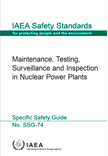 |
Maintenance, Testing, Surveillance and Inspection in Nuclear Power Plants
IAEA Safety Standards Series No. SSG-74 ¦ Specific Safety Guides ¦ English STI/PUB/2028 ¦ 89 pages ¦ Date published: 2022
Written for use by operating organizations of nuclear power plants and regulatory bodies, this Safety Guide provides specific recommendations on maintenance, testing, surveillance and inspection to ensure that the levels of reliability and availability of all structures, systems and components important to safety remain in accordance with the assumptions and intent of the design, and also that the safety of the plant is not adversely affected after the commencement of operation.
|
The publication covers the establishment and implementation of preventive and corrective maintenance programmes; testing surveillance and inspection; the repair of defective plant equipment; the provision of related facilities and equipment; procurement; and generating and retaining records of maintenance activities
|
 |
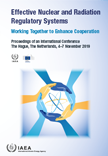 |
Working Together to Enhance Cooperation
Proceedings of an International Conference Held in The Hague, Netherlands, 4–7 November 2019
Proceedings Series ¦ English ¦ STI/PUB/2034 ¦ 52 pages ¦ Date published: 2022
Arising from the fifth in a series of international conferences on effective nuclear and radiation regulatory systems, this publication includes the opening addresses, a summary of the conference, and the conference President’s summary and conclusions. The participants’ presentations and posters from the conference are available as part of the online publication.
|
Ongoing challenges, such as capacity building for regulatory infrastructure, knowledge management, and safety and security culture are addressed. Emerging issues, such as those associated with new technologies and those related to ageing nuclear power plants and the back-fitting of current safety measures to existing nuclear power plants, and decommissioning and waste management, are considered, as is the threat posed by counterfeit and fraudulent items. An important concept throughout is the interface between safety and security. The objective of the publication is to share regulatory experiences related to improving the effectiveness of nuclear and radiation regulatory systems, addressing the international framework for the safety and security of nuclear and other radioactive material. A key message is that international cooperation to address regulatory challenges improves regulatory effectiveness worldwide.
|
 |
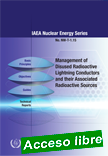 |
Management of Disused Radioactive Lightning Conductors and Their Associated Radioactive Sources
IAEA Nuclear Energy Series No. NW-T-1.15 ¦ English STI/PUB/2025 ¦ 90 pages ¦ 70 figures ¦ Date published: 2022
It was formerly hypothesized that placing a radioactive source near the end of a lightning conductor would improve the likelihood that lightning would strike the conductor. It is estimated that hundreds of thousands of these radioactive lightning conductors (RLCs) were installed worldwide. However, no convincing scientific evidence has been produced to demonstrate increased efficacy and the use of RLCs does not comply with the justification principle established in the International Basic Safety Standards.
|
Therefore, most countries have recognized the need to stop installing RLCs and to remove existing devices from the public domain. This publication summarizes all technical and organizational aspects related to the recovery and dismantling of RLCs as well as the safe management of the associated disused radioactive sources. The report describes the general arrangement, highlights the quality management components, identifies the staffing requirements and covers certain areas vital for the preparation for dismantling and source conditioning operations. Relevant information is provided on the various models of radioactive lightning conductors and how their design features influence the dismantling and source recovery operations. The publication also incorporates the most recent experience on various concluded projects in several Member States and captures the lessons learned.
|
 |
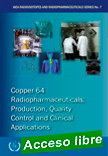 |
Copper-64 Radiopharmaceuticals: Production, Quality Control and Clinical Applications
IAEA Radioisotopes and Radiopharmaceuticals Series No. 7 ¦ English STI/PUB/1961 ¦ 125 pages ¦ 55 figures ¦ Date published: 2022
Positron emission tomography (PET) is an important clinical tool, and with its longer half-life, copper-64 has several unique attributes that make it a multi-purpose radionuclide with many potential applications. Additionally, copper as a trace element plays a pivotal role in several human metabolic and pathologic diseases and is involved in malignant cells biochemistry pathways.
|
This offers the opportunity for scientists to explore the theranostic capabilities of copper-64. This current publication, arising from an IAEA Coordinated Research Project, describes the biochemical and radiopharmaceutical aspects of copper-64, and its clinical applications, with specific guidelines and methods for the production of copper-64 chloride, peptide and monoclonal antibody radiopharmaceuticals. It is expected to be of use to all professionals involved in the field by specifying ideal production, formulation and quality control methods.
|
 |
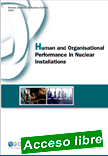 |
Human and Organisational Performance in Nuclear Installations
NEA No. 7579. Nuclear Energy Agency, OECD, 2022. 48 p.
This report from the NEA Working Group on Human and Organisational Performance establishes a common understanding around the terms human performance (HP), organisational performance (OP), and human and organisational factors (HOF) through a simple model. The model presented illustrates the strong inter-relationship between the terms. It shows that HP includes both human activities and the results of these activities.
|
HOF are the factors which have influence on HP in a positive or adverse manner in a given situation. They can be categorised as human-, technology- and organisation-related factors which are themselves under continuous interaction with each other. The report highlights the need for all managers to develop an understanding that the continuous application of a systemic approach is required to establish and sustain an effective management system and to foster safety culture.
|
 |
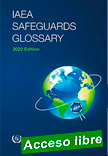 |
IAEA Safeguards Glossary
International Nuclear Verification Series No. 3 (Rev. 1) ¦ STI/PUB/2003 ¦ English ¦ 300 pages ¦ Date published: 2022
Since the last edition of the IAEA Safeguards Glossary in 2001, IAEA safeguards implementation has continued to evolve, with a greater emphasis on 'State as a whole' considerations in the development of State level safeguards approaches, and reflecting a myriad of technological advancements. This new edition reflects these developments and represents terms that are either specific and unique to IAEA safeguards, or those that may be used in other domains, but which have a specific meaning or application relevant to IAEA safeguards.
|
New terms that have come into common use over the past two decades have also been introduced. Each term includes a definition, and where applicable, further explanation or examples. Each section addresses a specific subject area relevant to IAEA safeguards, and the terms are arranged in relation to the subject area. Within each definition, terms that are defined elsewhere in the Glossary are italicized and an index referring to the term numbers has been provided for ease of reference. The terms have been translated into the official languages of the IAEA, as well as into German and Japanese.
|
 |
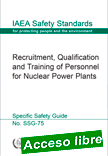 |
Recruitment, Qualification and Training of Personnel for Nuclear Power Plants
IAEA Safety Standards Series No. SSG-75 ¦ English ¦ STI/PUB/2029 ¦62 pages ¦ Date published: 2022
This Safety Guide identifies the main objectives and responsibilities of the operating organization for the recruitment, qualification and training of personnel for new and existing nuclear power plants to establish and maintain a high level of competence of personnel and to ensure safe operation of the nuclear power plant.
|
This publication can also be used as a guide for the recruitment, training and qualification of personnel for nuclear installations other than nuclear power plants.
|
 |
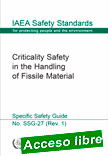 |
Criticality Safety in the Handling of Fissile Material
IAEA Safety Standards Series No. SSG-27 (Rev. 1) ¦ English ¦ STI/PUB/1995 ¦ 86 pages ¦Date published: 2022
The objectives of nuclear criticality safety are to prevent a self-sustained nuclear chain reaction. This Safety Guide provides guidance and recommendations on how to meet the relevant requirements for ensuring subcriticality when dealing with fissile material and for planning the response to criticality accidents. The recommendations address how to ensure subcriticality in systems involving fissile materials during normal operation and during credible abnormal conditions, from initial design through commissioning, operation and decommissioning.
|
This publication also provides recommendations on identification of credible abnormal conditions; performance of criticality safety assessments; verification, benchmarking and validation of calculation methods; safety measures to ensure subcriticality; and management of criticality safety. The guidance and recommendations are applicable to both regulatory bodies and operating organizations.
|
 |
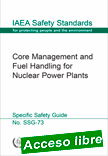 |
Core Management and Fuel Handling for Nuclear Power Plants
IAEA Safety Standards Series No. SSG-73 ¦ English ¦STI/PUB/2024 ¦ 55 pages ¦ Date published: 2022
Aimed primarily at operating organizations of nuclear power plants and regulatory bodies, this Safety Guide covers the safety objective of core management and the basic tasks of the core management programme. The receipt of fresh fuel, storage and handling of fuel assemblies and core components, the loading and unloading of fuel assemblies and core components, and the insertion and removal of other reactor materials are within the scope of this Safety Guide.
|
The publication also covers the preparations for the dispatch of irradiated fuel from the site.
|
 |
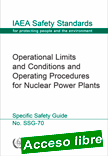 |
Operational Limits and Conditions and Operating Procedures for Nuclear Power Plants
IAEA Safety Standards Series No. SSG-70 ¦ English ¦ STI/PUB/2009 ¦ 47 pages ¦ Date published: 2022
The recommendations provided in this Safety Guide are aimed primarily at operating organizations of nuclear power plants and regulatory bodies. It covers the concept of operational limits and conditions (OLCs), their content as applicable to nuclear power plants, and the responsibilities of the operating organization for their establishment, modification, compliance and documentation.
|
Operating procedures (including emergency operating procedures and severe accident management guidelines) to support the implementation of the OLCs and to ensure their observance are also within the scope of this Safety Guide.
|
 |
| |
|
|

|
|
|
| |
|
|
| |
| |
|
|
| |
| |
|
|
| |
| |
|
|
|
| |
| |
